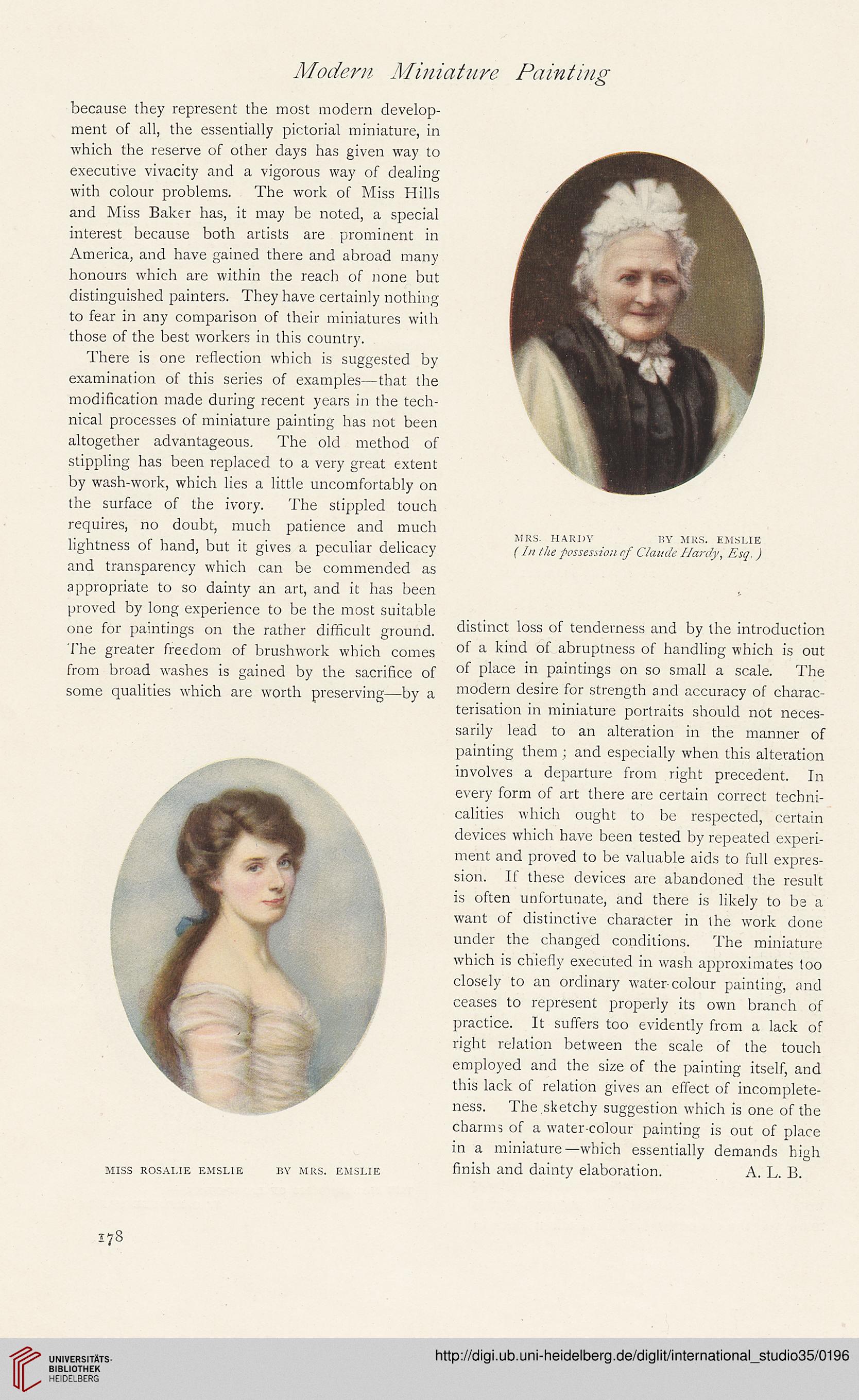Modern Miniature Painting
because they represent the most modem develop-
ment of all, the essentially pictorial miniature, in
which the reserve of other days has given way to
executive vivacity and a vigorous way of dealing
with colour problems. The work of Miss Hills
and Miss Baker has, it may be noted, a special
interest because both artists are prominent in
America, and have gained there and abroad many
honours which are within the reach of none but
distinguished painters. They have certainly nothing
to fear in any comparison of their miniatures with
those of the best workers in this country.
There is one reflection which is suggested by
examination of this series of examples—that the
modification made during recent years in the tech-
nical processes of miniature painting has not been
altogether advantageous. The old method of
stippling has been replaced to a very great extent
by wash-work, which lies a little uncomfortably on
the surface of the ivory. The stippled touch
requires, no doubt, much patience and much
lightness of hand, but it gives a peculiar delicacy
and transparency which can be commended as
appropriate to so dainty an art, and it has been
proved by long experience to be the most suitable
one for paintings on the rather difficult ground.
The greater freedom of brushwork which comes
from broad washes is gained by the sacrifice of
some qualities which are worth preserving—by a
MISS ROSALIE EMSLIE BY MRS. EMSLIE
MRS. HARDY BY MRS. EMSLIE
(In the possession of Claude Ilardy, Esq.)
distinct loss of tenderness and by the introduction
of a kind of abruptness of handling which is out
of place in paintings on so small a scale. The
modern desire for strength and accuracy of charac-
terisation in miniature portraits should not neces-
sarily lead to an alteration in the manner of
painting them ; and especially when this alteration
involves a departure from right precedent. In
every form of art there are certain correct techni-
calities which ought to be respected, certain
devices which have been tested by repeated experi-
ment and proved to be valuable aids to full expres-
sion. If these devices are abandoned the result
is often unfortunate, and there is likely to be a
want of distinctive character in the work done
under the changed conditions. The miniature
which is chiefly executed in wash approximates too
closely to an ordinary water colour painting, and
ceases to represent properly its own branch of
practice. It suffers too evidently from a lack of
right relation between the scale of the touch
employed and the size of the painting itself, and
this lack of relation gives an effect of incomplete-
ness. The .sketchy suggestion which is one of the
charms of a w'ater-colour painting is out of place
in a miniature—which essentially demands high
finish and dainty elaboration. A. L. B.
178
because they represent the most modem develop-
ment of all, the essentially pictorial miniature, in
which the reserve of other days has given way to
executive vivacity and a vigorous way of dealing
with colour problems. The work of Miss Hills
and Miss Baker has, it may be noted, a special
interest because both artists are prominent in
America, and have gained there and abroad many
honours which are within the reach of none but
distinguished painters. They have certainly nothing
to fear in any comparison of their miniatures with
those of the best workers in this country.
There is one reflection which is suggested by
examination of this series of examples—that the
modification made during recent years in the tech-
nical processes of miniature painting has not been
altogether advantageous. The old method of
stippling has been replaced to a very great extent
by wash-work, which lies a little uncomfortably on
the surface of the ivory. The stippled touch
requires, no doubt, much patience and much
lightness of hand, but it gives a peculiar delicacy
and transparency which can be commended as
appropriate to so dainty an art, and it has been
proved by long experience to be the most suitable
one for paintings on the rather difficult ground.
The greater freedom of brushwork which comes
from broad washes is gained by the sacrifice of
some qualities which are worth preserving—by a
MISS ROSALIE EMSLIE BY MRS. EMSLIE
MRS. HARDY BY MRS. EMSLIE
(In the possession of Claude Ilardy, Esq.)
distinct loss of tenderness and by the introduction
of a kind of abruptness of handling which is out
of place in paintings on so small a scale. The
modern desire for strength and accuracy of charac-
terisation in miniature portraits should not neces-
sarily lead to an alteration in the manner of
painting them ; and especially when this alteration
involves a departure from right precedent. In
every form of art there are certain correct techni-
calities which ought to be respected, certain
devices which have been tested by repeated experi-
ment and proved to be valuable aids to full expres-
sion. If these devices are abandoned the result
is often unfortunate, and there is likely to be a
want of distinctive character in the work done
under the changed conditions. The miniature
which is chiefly executed in wash approximates too
closely to an ordinary water colour painting, and
ceases to represent properly its own branch of
practice. It suffers too evidently from a lack of
right relation between the scale of the touch
employed and the size of the painting itself, and
this lack of relation gives an effect of incomplete-
ness. The .sketchy suggestion which is one of the
charms of a w'ater-colour painting is out of place
in a miniature—which essentially demands high
finish and dainty elaboration. A. L. B.
178





